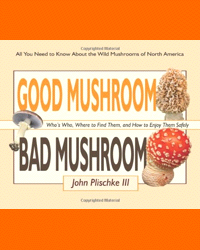There are plenty of times that even a little book can save your life. Now that it is Spring in the Northern Hemisphere, and the scent of the woods is urging you to pick up your mushrooming basket, don’t leave without slipping in John Plischke III essential guide, Good Mushroom Bad Mushroom: Who’s Who, Where to Find Them, and How to Enjoy Them Safely (St. Lynn’s PressFungi Magazine, and has received countless awards and taught hundreds of programs on mushrooms.
 The book starts with the basics of the hunt and identification, as well as how to preserve and prepare your haul. In bold capitals:
The book starts with the basics of the hunt and identification, as well as how to preserve and prepare your haul. In bold capitals:
If you are not 100% sure of the identification of mushrooms, don’t eat them. Remember the mushroomer’s saying: “When in doubt, Throw Them Out.” (p. viii)
Children learning to mushroom will enjoy the Basic Mushroom Anatomy diagram on p. ix and the common mushroom terms like Spore Print: “A spore print is a deposit of mushroom spore. The color of the spore print can be useful to help determine the type of mushroom and it may let you know if may have made a mistake in the mushroom’s identification.” The book teaches you how to make a spore print.
Plischke goes over inedible or poisonous mushrooms first with a lengthy description with several photographs, followed by a sections called Where, When, How to Look, Look-Alikes, and Edibility. The first is Berkeley’s Polypore, edible when immature, and then turning bitter. It resembles a “Gomphus or a bunch of whitish stalagmites.” (p. 1) The next mushroom has a more ominous name: Deadly Galerina (Galerina marginata) that closely resembles Stump Mushrooms, the Velvet Foot, and Magic Mushrooms, but unlike these edible mushrooms, has a rusty brown spore print. If you skip the spore print, eating this mushroom could lead to death.
Among the Edible mushrooms is Bear’s Head Tooth (Hericium americanum) is a strange looking mushroom without a cap – just rows of white teeth fastened on branches. They can be confused with Coral Mushrooms, some of which are poisonous. There are two pages on Chanterelle (Cantharellus cibarius) that are ready to be collected in Northeaster US in June. The poisonous look-alikes include Jack O’Lantern, Scaly Vase Chanterelle, and False Chanterelle. Plischke includes several mushroom recipes in the back of the book including Chanterelles and Liquor (p. 81) an infused alcohol. Better drink that after you sorted through your mushrooms!
